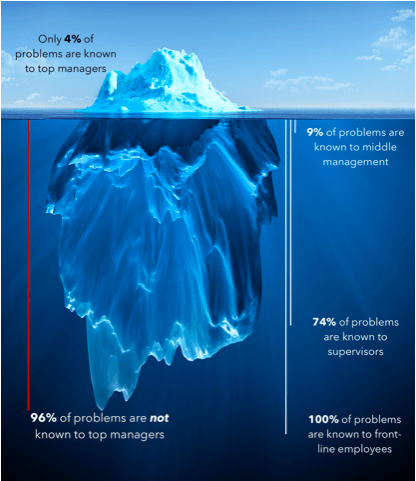I was a bit “rough around the edges” during my early years as a leader. As I continued to develop my leadership, I started to focus on how I could be of service to those around me as the bible calls us to do in 1 Peter.
“Each of you should use whatever gift you have received to serve others, as faithful stewards of God’s grace in its various forms.” 1 Peter 4:10 NIV
Today, people call this type of leading “servant leadership”.
A leader’s “fingerprint” can be found all throughout his or her organization. As I reflect back on our company, perhaps nowhere else was my bent toward servant leadership more evident, than in our organization chart!
Like most organizations, for years we had a conventional organization chart where I was at the top as the President/CEO.
As you well know, the typical org-chart signals to employees that they are all here to serve the person at the top.
However, I wanted to shake things up and reinforce the principle of servant leadership. So I asked our small leadership team to take on an attitude of an upside-down organization chart.
When we created that upside-down chart, I was at the bottom of the chart with the responsibility to serve, support, and equip the leadership team.
And in turn, they were to serve, support, and equip the front line people. And the customer was at the top so to signal that all of us were there to provide service excellence to the external customer.
From the top down, (or, more accurately: from the bottom up) I was beginning to embrace, teach, and exemplify the belief that customer satisfaction is a by-product of employee satisfaction.
This “People First” culture was further supported by the Nside/Outside principle.
Insight: The external customer experience will never exceed the employee experience.
For you see, I learned that outward success is an inside job!
Whatever is happening inside your organization is what will come out of your organization when servicing the external customer.
Are you, as the leader, ready to listen to and act upon employee feedback with quality improvement ideas for your organization?
If you aren’t ready, please do NOT implement the Nside/Outside principle until you are.
Every leader should listen to their employees because of the frustrations that follow when you ignore their input!
Employees become frustrated
Most leaders and organizations have never experienced employees being asked to offer quality improvement ideas or even being asked to be involved in the decision-making process.
If you implement the Nside/Outside principle, your employees are going to get really excited about being asked for their ideas and involvement.
The danger comes when you don’t listen to and act upon their feedback!
If you scrap your people’s ideas because you are not ready to receive them. or you feel like the people below you in your org-chart aren’t smart enough to come up with good ideas, then you are setting yourself up for monumental failure!
Your employees will become very frustrated with this experience. Wouldn’t you? If someone asked for your opinion but showed clear signs that they didn’t listen to your response, you would feel pretty hurt.
It’s as if you dangled a carrot in front of their noses, only to jerk it away as they reached for it.
WARNING: IF YOU FAIL TO LISTEN TO YOUR EMPLOYEES, YOU WILL FRUSTRATE THEM, AND SERIOUSLY ERODE THE TRUST AND RESPECT IN YOUR RELATIONSHIP WITH THEM.
Leaders become frustrated
Not only do you risk the frustration of your employees, but as a leader, you will become frustrated if you don’t listen to your people.
When you fail to listen to your people, you are cutting off a lifeline of valuable information.
This concept is powerfully illustrated in the acclaimed study, “The Iceberg of Ignorance”, commonly attributed to consultant Sidney Yoshida.
The study concluded: “Only 4% of an organization’s front line problems are known by top management, 9% are known by middle management, 74% are known by supervisors, and 100% are known by front line employees.”
I submit to you that part of your current frustration as a leader comes from not being aware of the underlying problems in your organization.
I also propose that your people, especially those who are on the front lines of your company, hold the answers to many of your questions!
Based on my own experience, I can say that when leaders fail to listen to their employees, they create an environment that frustrates both leader and employee alike.
Are you frustrated? What is the shape of your org-chart? Do you truly listen to everyone on your team? Could you share your comments <here> and share this blog post with a friend or co-worker?


